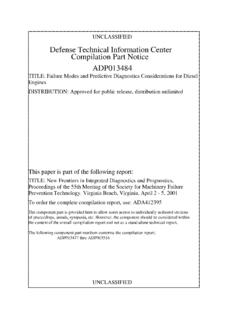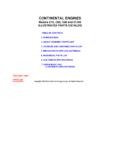Transcription of BY THE U.S. GENERAL ACCOUNTING OFFICE
1 BY THE GENERAL ACCOUNTING OFFICE . Report To The Chairman, Committee on Armed Services, United States Senate AD-A145 518. Performance Capabilities Of The C-5. And C-1 7 Cargo aircraft The performance capabilities of the Air Force C-5A/3 and C-17 cargo aircraft , inc, Jding their use at small, austere airfields, ha%'-- been the subject of considerable discussion within the Department of Defense and the Congress. Conflicting information has been presented on these aircraft . This report discusses information GAO obtained from the Air Force and contractors on the feasibility of using the C-5A/B and C-17 for small, austere airfield operations.
2 Information on other characteristics and performance ca- pabilities of each aircraft is also discussed..1. -- J. 'DTV0. SELECTIE. ~D ~-X ~ SEP 1018. bA . : GAO/NSIAD-84-1 19. ""-CCou4 '_ is xt_. t JULY 9. 1984. 84 09 07 071. Rejuest for copies of GAO reports shoul e sen o: GENERAL ACCOUNTING OFFICE Do ment Handling and Infor tion See ices Facility x 6015. Gaither rg, Md. 20760 /. Telephone 202) 275 1. The first five copie of lividual reports are free of charge. AJiin31 copies of bound audit reports are .25 each. Additional copies of unbound jeort ( , Jetter reports).
3 And most other 'blic~ions are each. Teewill be % discount on art orders for 100 or more pies mailecto a single address. Sales orders just be prepai on a cash, check, or money rder basis. Chec holuld be made out to e "Sueitedn ocuments". UNITED STATES GENERAL ACCOUNTING OFFICE . WASHINGTON, 20548. NATIONAL SECURITY AND. INTERNATIONAL APPIRS DIVISION. B-215103. The Honorable John G. Tower Chairman, Committee on Armed Services United States Senate Dear Mr. Chairman: In accordance with your letter, dated April 25, 1984, here is our report comparing the capabilities of the C-5 and C-17 cargo aircraft .
4 This report discusses Air Force and contractor informa- tion on the feasibility of using the C-SA/B and C-17 cargo air- craft in small, austere airfield1 operations. It also discusses other GENERAL characteristics and performance capabilities of both aircraft . The C-5A/B and C-17 differ in design and performance capa- bilities. However, because of the overall similarities in the misaion of each, the need for a new aircraft has caused consider- able discussion within both the Department of Defense and the Congress since 1980.
5 Conflicting information has been presented on the capabilities of these aircraft , including the suitability of their use at small, austere airfields. To compare the overall capabilities of each aircraft , we requested and reviewed relevant Air Force and contractor information. We placed emphasis on the small airfield capability of each aircraft because it has been a 'najor issue. The results of our review are summarized below and are presented in greater detail in appendixes I and II. Although the manufacturer disagrees, the Air Force, based on its 13 years of C-5A experience, believes -hat neither the C-5A.
6 Nor the C-SB can routinely and safely land or takeoff from small, austere airfields. The Air Force states that these operations would require operating near the limits of aircraft and aircrew capability with very little margin for safety. The Air Force further advised us that the C-5A/B is not suited for small air- field ground operations because of its large size and lack of maneuverability. It states that the C-SA/3 ground operations at small, austere airfields are difficult or impossible because of -obstructions and thea- size of the taxiways.
7 For these reasons, the Air Force states it will continue to restrict routine operations IThe Air Force generally defines a small, austere airfield as one that has runways less than 4,000 feet, has less than 100,000. square feet of ramp space, and lacks a ground support capability. ~wpi~r- lwao ai-a SuWINiA. -1 ku IdWibt~l~ioh U~ 4ukniftw B-215103. of the C-5A/B to runways 5,000 feet or longer. Although the C-5A/B has the capability to operate on unpaved surfaces, the Air Force states it will not base plans for wartime operations on this capability.
8 The Air Force and Lockheed-Georgia Company, the C-5A/B con- tractor, provided us differing estimates of aircraft takeoff, landing, and payload/range capabilities. Although Air Force and contractor estimates varied because of differing assumptions, the data provided by both show that the C-5B can carry its 261,000. pound maximum payload long distances without being refueled and that it can land in short distances. Air Force data show that the C-5B can carry 261,000 pounds of cargo 1,530 nautical miles; con- tractor data estimates it could carry such cargo 2,713 nautical miles.
9 Data provided by both show it can land within 2,600 feet or less with 170,000 pounds of cargo. Data provided by the Air Force and McDonnell Douglas Corpora- tion, the C-17 contractor, show that the C-17 is designid to carry its 172,200 pound maximum cargo load an unrefueled distance of about 2,900 nautical miles. This data also show that the C-17. will be able to land in 2,370 feet with a cargo load of 170,000. pounds. The C-17 will have several unique design features that, according to the Air Force, will enable it to routinely and safely takeoff, land, and operate at small, austere airfields.
10 The C-17's advantages in the small, austere airfield environment include its smaller size, better maneuverability using its backup capability, atd its combat offload capability. The Military Air- lift Command states that the C-17 will be able to perform any type of mission corrently assigned to the Command, including tactical airlift missions currently performed by the C-130. Appendix IlT provides the objectives, scope, and methodology used for our review. We are sending copies of this report to the Chairmen, Subcommittees on Defense of the House and Senate Committees on Appropriations; the Chairman, House Committee on Armed Services.

















